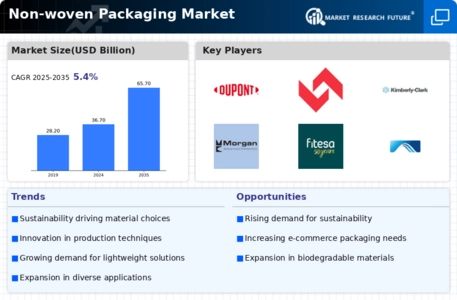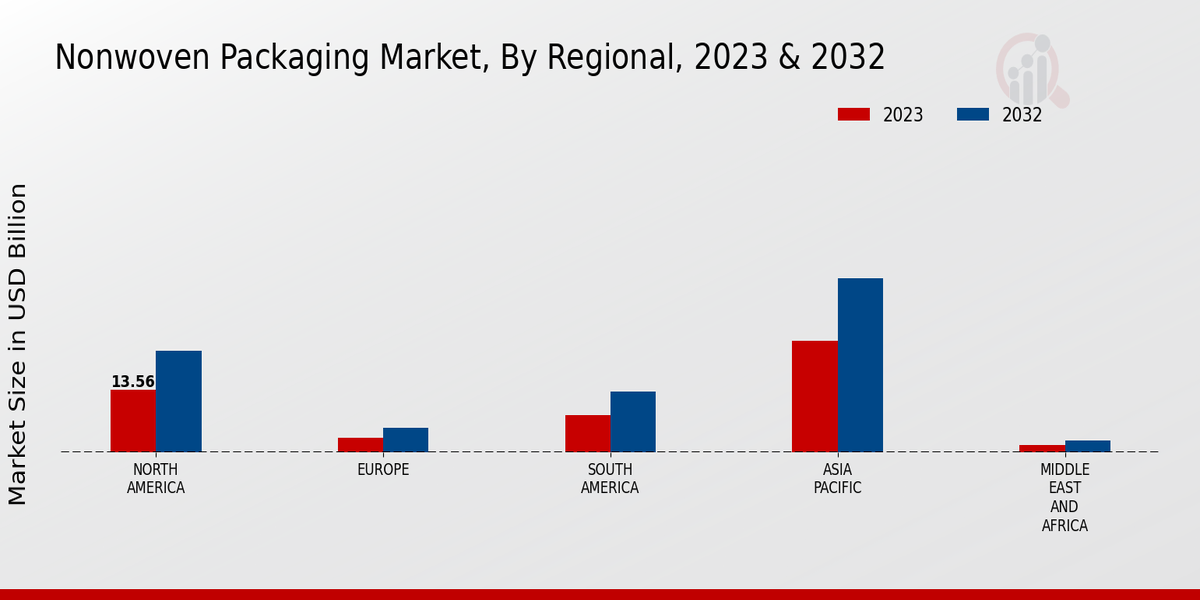Sustainability Trends
The Global Non-woven Packaging Market Industry is increasingly influenced by sustainability trends. Consumers and businesses alike are gravitating towards eco-friendly packaging solutions. Non-woven materials, often made from recycled fibers, present a viable alternative to traditional plastic packaging. This shift is not merely a trend but a necessity as regulatory frameworks tighten around plastic usage. For instance, countries are implementing bans on single-use plastics, thereby propelling the demand for sustainable non-woven options. The industry is projected to reach 36.7 USD Billion in 2024, reflecting the growing preference for environmentally responsible packaging.
Market Growth Projections
The Global Non-woven Packaging Market Industry is projected to experience substantial growth in the coming years. With a market value expected to reach 36.7 USD Billion in 2024 and 65.7 USD Billion by 2035, the industry is on a promising trajectory. The compound annual growth rate of 5.44% from 2025 to 2035 indicates a robust demand for non-woven packaging solutions across various sectors. This growth is driven by factors such as sustainability trends, technological advancements, and changing consumer preferences, positioning the non-woven packaging sector as a key player in the global packaging landscape.
Technological Advancements
Technological advancements play a pivotal role in shaping the Global Non-woven Packaging Market Industry. Innovations in manufacturing processes, such as spunbond and meltblown technologies, enhance the quality and functionality of non-woven materials. These advancements enable the production of lighter, stronger, and more versatile packaging solutions. For example, the integration of smart technologies into packaging, such as QR codes for tracking and recycling information, is gaining traction. As these technologies evolve, they are likely to drive market growth, contributing to an anticipated market value of 65.7 USD Billion by 2035.
Rising Demand in E-commerce
The rise of e-commerce is a significant driver for the Global Non-woven Packaging Market Industry. As online shopping continues to expand, the need for durable and protective packaging solutions becomes paramount. Non-woven packaging offers advantages such as lightweight properties and resistance to moisture, making it ideal for shipping various products. Companies are increasingly adopting non-woven materials to ensure product safety during transit. This trend is expected to contribute to a compound annual growth rate of 5.44% from 2025 to 2035, underscoring the growing reliance on non-woven packaging in the e-commerce sector.
Consumer Preferences for Convenience
Consumer preferences for convenience are reshaping the Global Non-woven Packaging Market Industry. As lifestyles become busier, consumers favor packaging that is easy to use and dispose of. Non-woven packaging solutions, such as reusable bags and easy-to-open pouches, align with these preferences. This shift is evident in the food and beverage sector, where brands are increasingly opting for non-woven materials to enhance user experience. The growing inclination towards convenience-driven products is likely to sustain market growth, as consumers seek packaging that complements their fast-paced lives.
Regulatory Support for Non-woven Materials
Regulatory support for non-woven materials is emerging as a crucial driver in the Global Non-woven Packaging Market Industry. Governments worldwide are promoting the use of non-woven packaging as part of broader initiatives to reduce plastic waste. Incentives for manufacturers adopting sustainable practices and materials are becoming more common. This regulatory landscape not only encourages innovation but also fosters a competitive environment for non-woven packaging solutions. As regulations tighten around traditional plastics, the non-woven sector is poised for growth, aligning with global sustainability goals.












